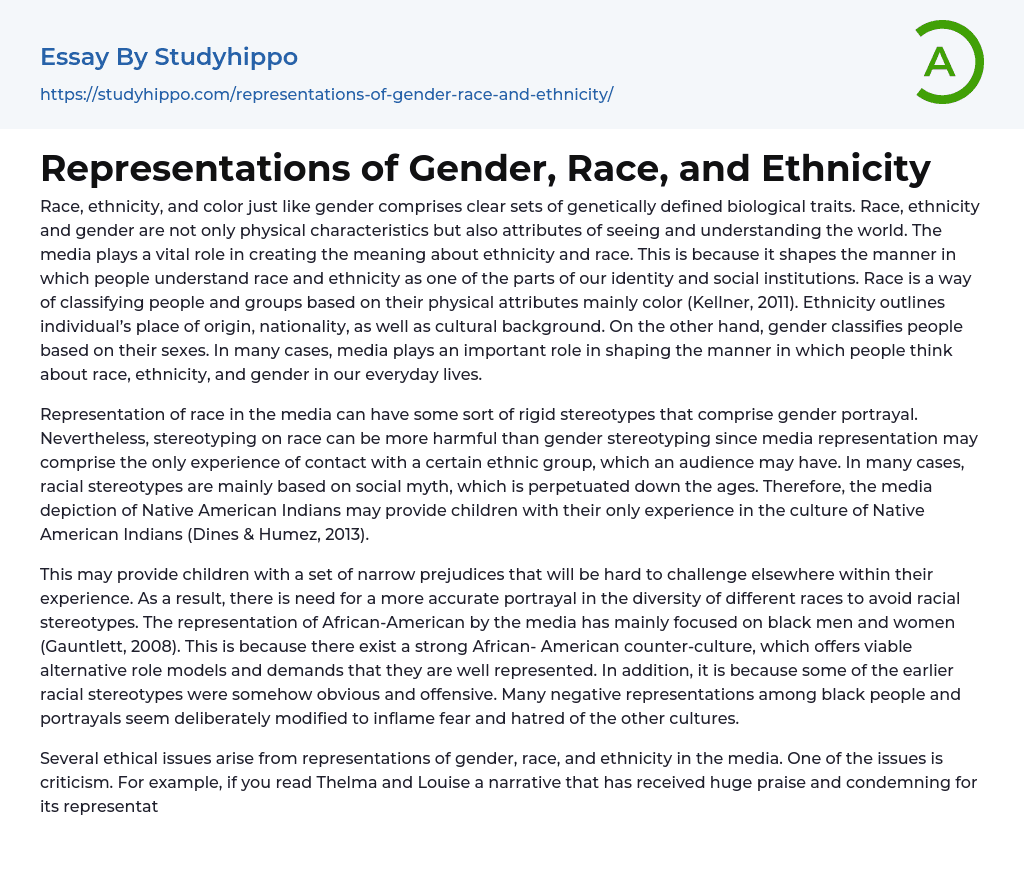

Representations of Gender, Race, and Ethnicity Essay Example
Race, ethnicity, and color just like gender comprises clear sets of genetically defined biological traits. Race, ethnicity and gender are not only physical characteristics but also attributes of seeing and understanding the world. The media plays a vital role in creating the meaning about ethnicity and race. This is because it shapes the manner in which people understand race and ethnicity as one of the parts of our identity and social institutions. Race is a way of classifying people and groups based on their physical attributes mainly color (Kellner, 2011). Ethnicity outlines individual’s place of origin, nationality, as well as cultural background. On the other hand, gender classifies people based on their sexes. In many cases, media plays an important role in shaping the manner in which people think about race, ethnicity, and gender in our everyday lives.
Represen
...tation of race in the media can have some sort of rigid stereotypes that comprise gender portrayal. Nevertheless, stereotyping on race can be more harmful than gender stereotyping since media representation may comprise the only experience of contact with a certain ethnic group, which an audience may have. In many cases, racial stereotypes are mainly based on social myth, which is perpetuated down the ages. Therefore, the media depiction of Native American Indians may provide children with their only experience in the culture of Native American Indians (Dines & Humez, 2013).
This may provide children with a set of narrow prejudices that will be hard to challenge elsewhere within their experience. As a result, there is need for a more accurate portrayal in the diversity of different races to avoid racial stereotypes. The representation of African-American by the medi
has mainly focused on black men and women (Gauntlett, 2008). This is because there exist a strong African- American counter-culture, which offers viable alternative role models and demands that they are well represented. In addition, it is because some of the earlier racial stereotypes were somehow obvious and offensive. Many negative representations among black people and portrayals seem deliberately modified to inflame fear and hatred of the other cultures.
Several ethical issues arise from representations of gender, race, and ethnicity in the media. One of the issues is criticism. For example, if you read Thelma and Louise a narrative that has received huge praise and condemning for its representation of both women and men. Many women considered this narrative as a "betrayal of feminism” (Sturken, 2010). This view is quite disturbing because it has implicit assumptions about women nature and their universality in response to texts and day-to-day activities. For example, many critics claimed that Thelma would not manage to pick up a hitchhiker for sex immediately after a near rape while other argued that Louise would tell her a secret to close a friend.
This responses and criticism shows an essentialism that emphasizes on one way of portraying women ethically which is valorizing "positive" "feminine" traits. This criticism creates a real danger in clearly reifying stereotyped beliefs concerning women adopting such a position. It serves as a way of demeaning rather than challenging. It is clear that Thelma and Louise is a complex text that supports and sub diverts major ideas about gender. I find the film to have some places of resistance especially the use of theories of cultural negotiation and personality. Many media representation
have depicted women as objects of the “male gaze.” In doing so, they have demeaned women who are powerful in the society. This stereotype has continued to filtrate in the minds of many people. In addition, other women still demean their fellow women. It sets a bad example to the youth.
In order to have clear understanding of cultural meaning attributed to certain races and ethnicities, it is good to examine their historical origins and ideologies. This is because many of the American ideas about race and ethnicity originated from certain moments in history characterized by immigration and colonialism. The intermixing of races and ethnicities led to dominant groups that exerted influence over other groups therefore occupying and controlling certain issues like culture, language, and rituals. For example, the white group gained dominance whereas the subordinate groups were politically, socially, and economically marginalized. Another good example is the Little Black Sambo (1935) clip, which shows rigid and reductive stereotyping. In 1935, it was considered a harmless entertainment (Williams, Martins, Consalvo & Ivory, 2009). However, today the clip representation is considered unacceptable to the society. This clip is good example of cultural shift over the last years.
Conclusion
In conclusion, it is clear that race gender, and ethnicity has played a role in freedom of many people through media representation. For example, you may find isolated because of your race and ethnic background. Sometimes it can be hard to see people who look like you represented in media, stories, and school. In addition, you may find yourself being complimented because of your race or ethnic background instead of your achievement. This shows that the media has propagated certain stereotypes
in the society. Therefore, there is need to create balance in race, ethnicity and gender representation in the media.
References
- Kellner, D. (2011). Cultural studies, multiculturalism, and media culture. Gender, race, and class in media: A critical reader, 7-18.
- Dines, G., & Humez, J. M. (2013). Gender, race, and class in media: A text-reader. Sage.
- Gauntlett, D. (2008). Media, gender and identity: An introduction. Routledge.
- Sturken, M. (2010). Thelma and Louise. London: British Film Institute.
- Williams, D., Martins, N., Consalvo, M., & Ivory, J. D. (2009). The virtual census: Representations of gender, race and age in video games. New Media & Society, 11(5), 815-834.



